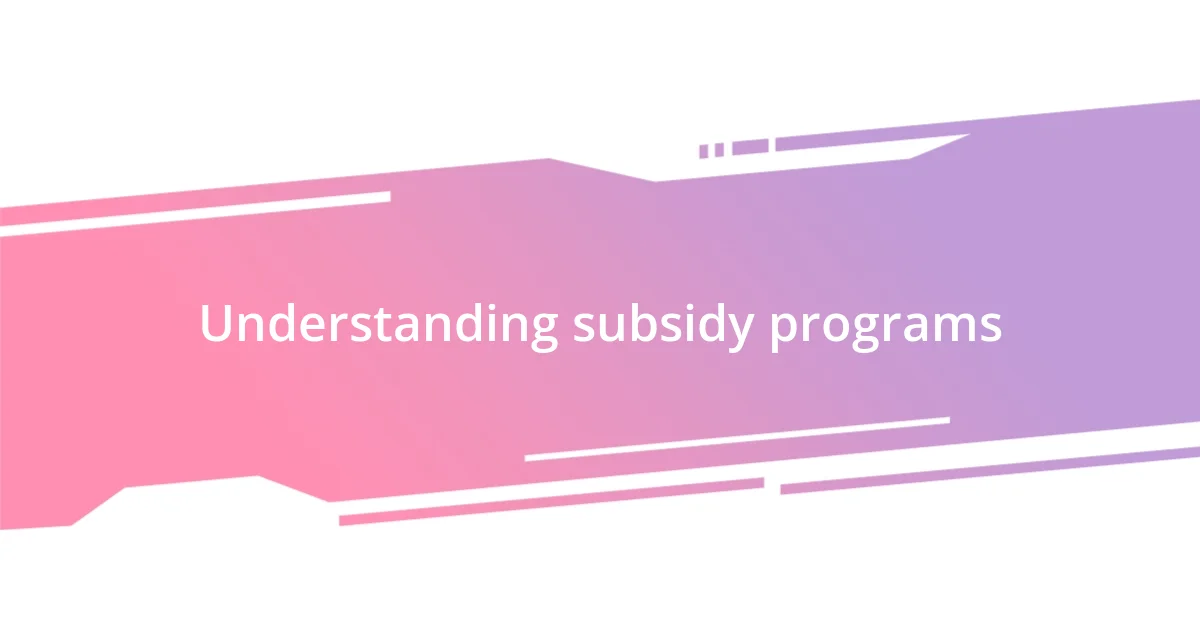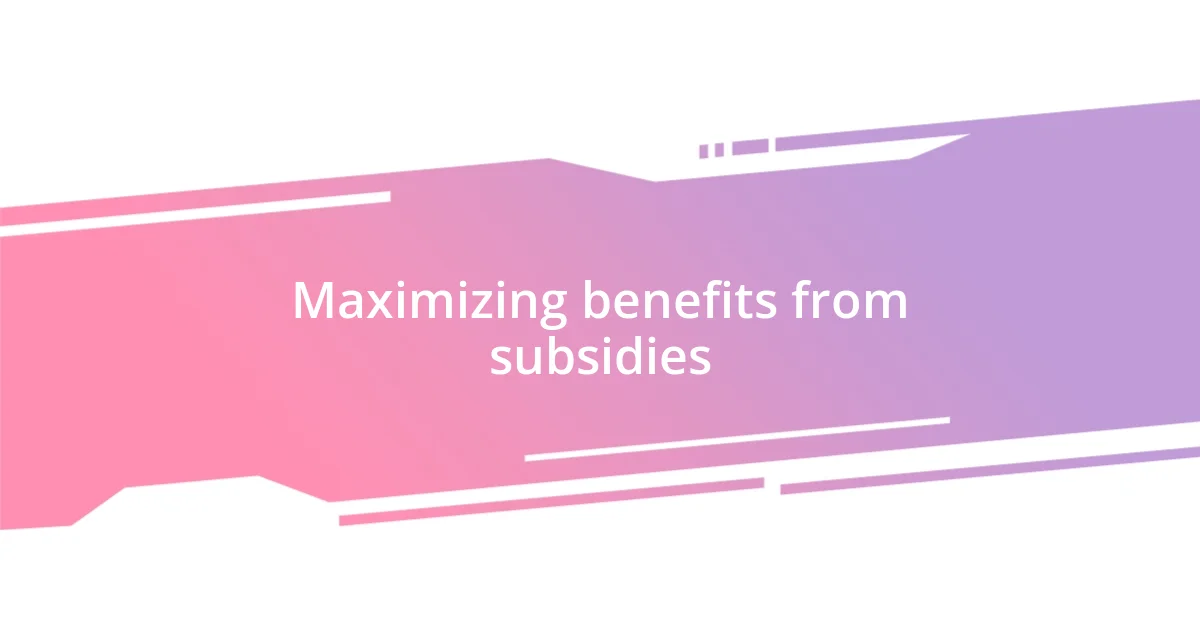Key takeaways:
- Understanding and navigating subsidy programs can lead to significant opportunities for personal and business growth.
- Thorough research and preparation are crucial for selecting suitable programs and crafting effective applications, incorporating personal narratives to enhance relatability.
- Continuous engagement, networking, and learning from setbacks are essential for maximizing benefits from subsidies and ensuring long-term success.

Understanding subsidy programs
Subsidy programs are designed to support individuals, businesses, or sectors by providing financial aid, thereby reducing economic burdens. I remember when I first discovered how a local subsidy helped my neighbor launch his bakery; it was both inspiring and eye-opening to see how such programs can transform lives. Have you ever thought about how much easier starting a business could be with the right support?
These programs often target essential areas, such as renewable energy, agriculture, or education, reflecting a government’s commitment to fostering growth and stability. I once participated in a training program funded by a subsidy, and it completely changed my career trajectory. Seeing the potential impact of these financial aids makes me wonder—how many opportunities might we overlook simply because we aren’t aware of the available support?
Understanding the application process can be daunting, yet it’s crucial for tapping into these resources. I recall the mixed feelings of confusion and hope when I started my application—would I qualify? Navigating through requirement details can be overwhelming, but I can assure you that the potential rewards are well worth the effort.

Identifying suitable programs
Identifying the right subsidy program can feel like searching for a needle in a haystack, but it’s essential for maximizing your benefits. When I was exploring options for my own small business, I started by narrowing down programs that addressed my specific needs. I remember spending hours online and making calls, only to discover that some programs were tailored precisely for businesses in my sector. Have you ever felt that thrill when you finally find something that aligns perfectly with your goals?
It’s important to consider factors such as eligibility, funding limits, and application requirements before committing to a program. I once applied for a program that seemed promising but later found out that its criteria didn’t apply to my business type. This experience taught me the value of thorough research. Trust me, investing time upfront to identify suitable programs can save you from the disappointment of wasted efforts.
To help streamline the process, I created a comparison table to evaluate various subsidy programs. This approach enabled me to visualize which options would be the best fit and led to quicker decision-making. I encourage you to try this method; it might just make your search easier and more efficient.
| Program Name | Eligible Sectors |
|---|---|
| Renewable Energy Grant | Energy & Sustainability |
| Small Business Innovation Program | Technology Startups |
| Agriculture Assistance Fund | Agriculture |
| Education Support Program | Educational Institutions |

Preparing applications effectively
Preparing applications effectively is where the magic truly happens. I vividly recall that late-night scramble when I was fine-tuning my application for a local business subsidy. The process felt overwhelming at times, yet I noticed that breaking it down into manageable parts made a significant difference. Keeping a checklist helped me ensure every detail was accounted for, but that wasn’t all—adding personal stories to my application made it resonate more with the reviewers. For me, it was like painting a vivid picture of my goals and aspirations.
Here are some practical tips to prepare your application effectively:
- Understand the Guidelines: Read the application guidelines carefully to avoid common pitfalls. Missing even a small detail could result in rejection.
- Craft a Clear Narrative: Share your story. Explain not just what you do, but why it matters. I found that narrating my journey made it more relatable.
- Be Specific: Use specific examples and data to support your claims. When applying for one program, I included market research that highlighted my business’s potential impact.
- Seek Feedback: Get someone else to review your application. A fresh perspective can catch mistakes I might overlook.
- Stay Organized: Create a timeline for completing each section. This helps keep anxiety at bay and ensures all parts are complete before submission.
I remember feeling a sense of accomplishment once my application was submitted, hopeful that my efforts would pay off. It reinforced the significance of thorough preparation—knowing I had done everything I could to present my case made the waiting game a little less nerve-wracking.

Maximizing benefits from subsidies
Maximizing benefits from subsidies isn’t just about the initial application; it requires an ongoing commitment to engage with the offered resources. One thing I learned is the importance of following up after submitting my application. I remember the anxious moments checking my inbox, but I also took the initiative to reach out and ask for updates. This proactive approach not only kept me informed but also demonstrated my enthusiasm. Have you ever thought about how little gestures like this can set you apart?
Alongside this, I found that networking within the community of subsidy recipients can open up additional opportunities for support and advice. I attended a local meet-up for applicants and was surprised by how much I learned about optimizing the benefits from the subsidy program. It felt like gaining insider knowledge that could be the key to unlocking more options. Don’t underestimate the power of connecting with others; sometimes, shared experiences can highlight pathways you hadn’t thought of.
Lastly, I made it a habit to regularly review and adjust my project plans based on the feedback I received during the subsidy period. When I implemented changes suggested by my peers and mentors, I noticed a tangible improvement in my outcomes. Reflecting on my journey, I realize that maximizing benefits isn’t just about the money; it’s about growth, learning, and building a stronger foundation for the future. How have you navigated relationships to amplify your success?

Common mistakes to avoid
When applying for subsidy programs, one of the biggest mistakes I see is overlooking the specific eligibility requirements. I remember vividly how my excitement led me to rush through the fine print, only to realize a week later that my business didn’t meet a crucial criterion. That moment was disappointing—it felt like I had wasted valuable time. Have you ever felt that sting of oversight? It’s a simple but vital reminder: take the time to understand these details, as they can save you from unnecessary heartache.
Another mistake I learned the hard way was submitting an application that didn’t effectively convey my vision. Early on, my application read like a dry list of numbers rather than a compelling story. After receiving feedback from a mentor, I decided to infuse my application with emotion and passion. This shift not only made my submission stand out but also connected on a human level with the reviewers. It’s fascinating how numbers alone can’t tell the full story; isn’t it essential to share your ‘why’?
Lastly, not engaging in post-submission communication can be detrimental. I’ve often seen applicants enter a state of inaction after hitting ‘send.’ After one application that I was particularly invested in, I took the initiative to call the program coordinator for updates. That simple act not only diminished my anxiety but also made a lasting impression. Have you considered reaching out post-application? I’ve found that these connections can keep you informed and keep your application top-of-mind for reviewers.

Success stories and testimonials
Success stories often reside in the simplest of interactions. I recall a fellow applicant who shared how an informal conversation at a networking event completely changed her approach. She was initially set on a narrow path for her project, but after discussing her ideas with someone who had navigated the same subsidy program successfully, she broadened her horizons. It made me wonder: how often do we limit our potential by sticking to our own perspectives?
Another inspiring testimonial comes from a close friend who secured a significant subsidy for her small business. She emphasized that the key was in the follow-ups—after submitting her application, she reached out not just once, but repeatedly. This persistence paid off when she received invaluable tips that helped refine her project proposal. Doesn’t it feel amazing to think that determination can lead to unexpected opportunities?
I also came across a story of a young entrepreneur who turned his rejection into a stepping stone. Instead of giving up after his first application was denied, he sought feedback and used it to strengthen his next submission. His resilience ultimately led to funding, transforming his dream into a thriving venture. Have you ever considered how setbacks can serve as a foundation for greater success? It’s a powerful reminder that resilience may be just as important as the initial application itself.

Resources for continuous improvement
Understanding that continuous improvement is essential in subsidy programs has been a game-changer for me. I often lean on online communities and forums, where experiences are shared openly. These platforms offer not just advice but also a sense of camaraderie. Aren’t we all looking for that connection in our entrepreneurial journeys?
In addition to communities, I’ve found immense value in workshops tailored to subsidy applications. I remember attending one that completely transformed my approach. The speaker, who had years of experience, shared real-life case studies that illuminated common pitfalls and successful strategies. I walked away not just with notes, but also with a renewed enthusiasm. Have you ever left a workshop feeling ready to tackle the world?
I’ve also made it a habit to follow industry experts through newsletters and social media. Their insights often provide a fresh perspective on navigating these programs. Once, I stumbled across a blog post that explained how to leverage data in applications—an approach I hadn’t considered before. It sparked a realization: sometimes, the right resource can open up entirely new pathways to success. How often do we overlook the power of simply staying informed?












